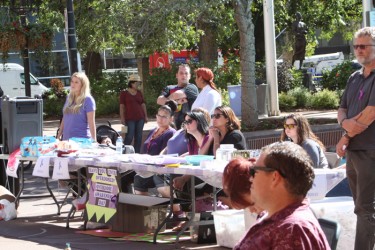Article Origin
Volume
Issue
Year
Fentanyl focus of Overdose Awareness Day
Members of the Streetworks team handed out information on naloxone, overdose facts, and harm reduction as part of Overdose Awareness Day, held outside City Hall in downtown Edmonton on Aug. 31. With nearly 100 people in attendance, speakers included Alberta Health Services’ medical health officer Chris Sikora, David Shepherd (MLA Edmonton-Centre), and Scott McKeen (Edmonton city councillor). Petra Shulz (mother of Danny Shulz, who passed away due to overdose) and Jenn (a member of the Streetworks team) shared their stories of how overdose affected them. Between 2011 and 2014, there were 162 fentanyl-detected deaths in Alberta. If fentanyl-implicated deaths and pending cases are included that number increases to 221. In response to the growing number of fentanyl related overdose deaths AHS has created a province-wide take home naloxone kit program. Naloxone is a drug that temporarily reverses the symptoms of overdose so that a person may receive medical treatment.
Aboriginal presenters, issues at upcoming Litfest
Litfest, Edmonton’s nonfiction festival, will have a distinctively Aboriginal flavour this year. “Just Words” is a panel discussion that will bring together Tanya Kappo (contributor from The Winter We Dance: Tales from the Idle No More Movement) and authors Shawna Ferris (Street Sex Work and Canadian Cities: Resisting a Dangerous Order) and Lori Shenher (That Lonely Section of Hell: Living Inside the Failed Investigation of a Serial Killer) to discuss the challenges, setbacks and struggle to find justice for Canada’s missing and murdered Indigenous women.
Outspoken Aboriginal activist, academic and now first-time author Wab Kinew and veteran author Drew Hayden Taylor will also be presenting. The event takes place between Oct. 15-25 at a number of venues across the city.
Street origins focus of St. Albert museum exhibition
Musée Héritage Museum in St. Albert is running a new exhibit entitled The Street Where You Live. This exhibition will reveal the†identities and stories of many of the individuals and families whose lives merited public acknowledgement by having a street named in their honour. The street signs are a catalogue of interesting people who have contributed to St Albert, from the early Métis, who lived and worked in the area, to the Mission’s founders, business people and community builders. The exhibition includes some amazing stories, says museum spokesperson Danielle Antoniuk. There is also information about many of the other street names, which patrons can investigate on their own. The exhibition runs until Nov. 15.
Aboriginal art park first of its kind in Canada
A public call has gone out to Aboriginal artists and artist teams throughout Canada for work to be included in the city’s Aboriginal art park. The Aboriginal art park was approved as part of the Queen Elizabeth Park Master Plan in August 2013. Artworks in diverse mediums as well as contemporary and customary (traditional) disciplines will in some way ‘tell the stories of this place’ and respond to the land within the Aboriginal art park and/or the land in the region through an engaged process with Edmonton’s urban Aboriginal communities, Treaty 6 First Nations, Métis and local Elders and knowledge holders. The selection process will be done in two-stages. Shortlisted artists will participate in a site visit and workshop with curator Candice Hopkins prior to preparing full proposals. Hopkins is a member of the Carcross Tagish First Nation in the Yukon, Gaanax.·di clan, a member of the BC MÈtis Association, and the chief curator of the IAIA Museum of Contemporary Native Arts. “The Aboriginal art park is unique and the first initiative of its kind in Canada,” said Hopkins. “I believe that the Aboriginal art park will create a platform for Aboriginal voices, through artworks that will provide a vision for the future.” Up to six artworks will be selected. A steering committee that includes representation from the Confederacy of Treaty Six, Métis Nation of Alberta, Elders, Aboriginal artists, the City of Edmonton, Edmonton Arts Council, and community members provides leadership, strategic direction and advice to the project team as well as ensuring protocols are observed.
U of A dean to return to native New Zealand
Brendan Hokowhitu, dean of the faculty of Native studies for the University of Alberta, will be moving on.
Hokowhitu, a native Maori of New Zealand, came to the U of A from the University of Otago, New Zealand. He will return to New Zealand to become the dean of Te Pua Wnanga ki te Ao, the School of Mori and Pacific Development at the University of Waikato. Hokowhitu joined the U of A July 1, 2012. During his tenure as dean, Hokowhitu focused on increasing undergraduate and graduate enrolment in the faculty and led the development of an Indigenous Studies Doctoral Program proposal. He provided effective leadership working across the university to engage with other faculties to develop a number of initiatives. Hokowhitu has also led online programming in Native studies. Hokowhitu’s resignation is effective Jan. 4, 2016. Dr. Chris Andersen will serve as interim dean from Jan. 4, 2016, to June 30, 2017.
History series to promote understanding
The Amiskwaciy History Series will launch on Sept. 21 at City Hall. The series is a new Aboriginal grassroots initiative aimed at creating awareness of the Indigenous history of Edmonton. Through free monthly sessions, the group hopes to provide accessible and culturally appropriate education to the public on Aboriginal history as lived and told by the people. A group of eight, which includes Elders, community advocates, social agency representatives and artists from Indigenous backgrounds, are organizing the grassroots initiative with support from the City of Edmonton, Edmonton Public Library and Niginan Housing Ventures. Leading up to the launch, three free educational sessions were held in different branches of the Edmonton Public Library. “We find when people understand the history of Aboriginal people in Edmonton, they seem to have a little more understanding of where we were and where we’re going,” said committee member Karen Bruno.
- 1178 views

